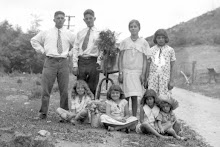
In Greece, New Year is perhaps even more festive and important then Christmas as it is the main day for gift-giving. It is a time of hope and promise, and it is also St. Basil's Day. St. Basil (Vassilios) was one the forefathers of the Greek Orthodox Church, and he is remembered for his kindness and generosity to the poor. He is thought to have died on this date so this is how they honor him. Stories of his kindness to children are shared at this time, remembering how he would come in the night and leave gifts for the children in their shoes. There is always much visiting, feasting, and music to be enjoyed.
There are many special dishes that are prepared at New Year but the most important dish is Vasilópita (or St. Basil's cake) (read more about it further down on the page). As well as the cake, there is usually an abundance of food on the table including Kourabiedes (Greek shortbread) and Thiples (wafer-thin honeyed phyllo spirals). Also, there is always honey on the table, and olive-branches, nuts, fresh fruit, and other symbols of happiness and wealth.
On New Year’s Eve and New Years Day the children sing carols. The first person across the threshold of the house on New Year's Day is said to bring the family good luck throughout the coming year. The father, son or a lucky child was meant to be the first person across the threshold. A lucky child was someone who has both parents still alive.
Vasilópita (or St. Basil's cake) is a sweet nut cake with a coin hidden inside, traditionally served on New Year's Eve, when families honor Saint Basil (St. Vasilios, or Santa Claus), who comes down to earth on that day.
The New Year Cake came from the story about Saint Basil who it is said told how he helped the poor people to pay their taxes. According to the story, he took some jewelry from each person and gave it to the Governor. The Governor was sorry for the poor people and so he gave the jewelry back, they only problem was Basil did not know who owned each piece of jewelry. This is when it is told the miracle occurred. He baked each piece inside a loaf and when the loaves were
given out, everyone had their own jewelry in the piece of loaf.
Today, a gold coin (flouri) is hidden inside the cake after baking, and the cake is cut on New Year's Eve with all the family present. The pieces are distributed in a predetermined order: the first is for Christ, the second for Mary, the third is for St. Vasilios, the fourth for the house, the fifth for the head of the family, the sixth for the mother, then one for each of the children. A piece is also cut for each absent member of the family. Whoever finds the coin can look forward to special success in the coming year.
- 1 pkg active dry yeast (not fast rising)
- 3/4 C milk, lukewarm
- 3 eggs, beaten
- 1-1/2 t grated orange rind
- 3/4 C sugar
- 4-1/2 C plain flour
- 1/4 t salt
- 1/2 t cinnamon
- 1/4 t mastich, ground (I didn't have this and didn't have time for a trip to the Greek store, so I skipped it)
- 1/2 C butter, melted
- 1 egg for glazing
- Powered sugar, milk and vanilla for icing
- Slivered almonds
Dissolve yeast in 1/4 C of the milk
Add remainder of the milk, plus the eggs, orange rind and sugar.
Sift 3 cups flour, salt and spices into a warm bowl and make a well in the centre.
Pour in yeast mixture and stir to blend in flour, gradually adding warm melted butter.
Mix dough with hands until it comes away from sides.
Turn on to a floured surface and knead until smooth and elastic, adding remaining flour as required. Knead for 10 minutes.
Place ball of dough in a clean bowl brushed with melted butter.
Turn dough over to coat top with butter and cover bowl with a cloth or plastic wrap.
Leave to proof (rise) in a warm place until doubled in size.
Punch down and turn on to lightly floured surface.
Knead lightly and shape into a round loaf (or your desired shape).
Place on a large greased baking sheet or in a greased 10 inch deep cake tin.
Cover and let rise in a warm place until doubled about 1 1/2 to 2 hours.
Glaze with well-beaten egg.
Bake in a moderately hot oven for 45 minutes until golden brown and cooked when tested.
If bread browns too quickly place a piece of greased brown paper on top.
Cool on a wire rack.
Once cooled, remove from the pan, make a slit at the bottom and insert a clean coin wrapped in foil. Return to pan or place on serving dish. Top with icing and almonds.
NOTE: If you prefer not to use an icing, other options are to top the break prior to baking with just slivered almonds or sesame seeds.



